俄罗斯政治体系【英文】
- 格式:ppt
- 大小:1.15 MB
- 文档页数:30

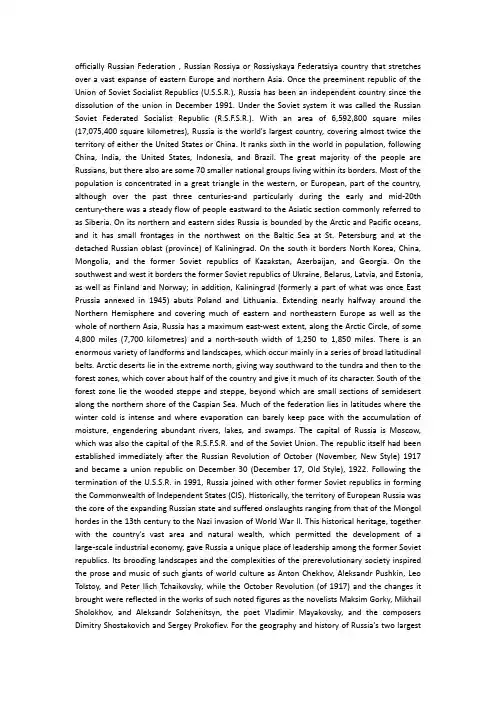
officially Russian Federation , Russian Rossiya or Rossiyskaya Federatsiya country that stretches over a vast expanse of eastern Europe and northern Asia. Once the preeminent republic of the Union of Soviet Socialist Republics (U.S.S.R.), Russia has been an independent country since the dissolution of the union in December 1991. Under the Soviet system it was called the Russian Soviet Federated Socialist Republic (R.S.F.S.R.). With an area of 6,592,800 square miles (17,075,400 square kilometres), Russia is the world's largest country, covering almost twice the territory of either the United States or China. It ranks sixth in the world in population, following China, India, the United States, Indonesia, and Brazil. The great majority of the people are Russians, but there also are some 70 smaller national groups living within its borders. Most of the population is concentrated in a great triangle in the western, or European, part of the country, although over the past three centuries-and particularly during the early and mid-20th century-there was a steady flow of people eastward to the Asiatic section commonly referred to as Siberia. On its northern and eastern sides Russia is bounded by the Arctic and Pacific oceans, and it has small frontages in the northwest on the Baltic Sea at St. Petersburg and at the detached Russian oblast (province) of Kaliningrad. On the south it borders North Korea, China, Mongolia, and the former Soviet republics of Kazakstan, Azerbaijan, and Georgia. On the southwest and west it borders the former Soviet republics of Ukraine, Belarus, Latvia, and Estonia, as well as Finland and Norway; in addition, Kaliningrad (formerly a part of what was once East Prussia annexed in 1945) abuts Poland and Lithuania. Extending nearly halfway around the Northern Hemisphere and covering much of eastern and northeastern Europe as well as the whole of northern Asia, Russia has a maximum east-west extent, along the Arctic Circle, of some 4,800 miles (7,700 kilometres) and a north-south width of 1,250 to 1,850 miles. There is an enormous variety of landforms and landscapes, which occur mainly in a series of broad latitudinal belts. Arctic deserts lie in the extreme north, giving way southward to the tundra and then to the forest zones, which cover about half of the country and give it much of its character. South of the forest zone lie the wooded steppe and steppe, beyond which are small sections of semidesert along the northern shore of the Caspian Sea. Much of the federation lies in latitudes where the winter cold is intense and where evaporation can barely keep pace with the accumulation of moisture, engendering abundant rivers, lakes, and swamps. The capital of Russia is Moscow, which was also the capital of the R.S.F.S.R. and of the Soviet Union. The republic itself had been established immediately after the Russian Revolution of October (November, New Style) 1917 and became a union republic on December 30 (December 17, Old Style), 1922. Following the termination of the U.S.S.R. in 1991, Russia joined with other former Soviet republics in forming the Commonwealth of Independent States (CIS). Historically, the territory of European Russia was the core of the expanding Russian state and suffered onslaughts ranging from that of the Mongol hordes in the 13th century to the Nazi invasion of World War II. This historical heritage, together with the country's vast area and natural wealth, which permitted the development of a large-scale industrial economy, gave Russia a unique place of leadership among the former Soviet republics. Its brooding landscapes and the complexities of the prerevolutionary society inspired the prose and music of such giants of world culture as Anton Chekhov, Aleksandr Pushkin, Leo Tolstoy, and Peter Ilich Tchaikovsky, while the October Revolution (of 1917) and the changes it brought were reflected in the works of such noted figures as the novelists Maksim Gorky, Mikhail Sholokhov, and Aleksandr Solzhenitsyn, the poet Vladimir Mayakovsky, and the composers Dimitry Shostakovich and Sergey Prokofiev. For the geography and history of Russia's two largestcities, see the articles Moscow and Saint Petersburg. For the history of the Soviet Union as a whole, from the Revolution to 1991, see Union of Soviet Socialist Republics. For the geography and history of the other former Soviet republics, see Moldova, Estonia, Latvia, Lithuania, Belarus, Kazakstan, Kyrgyzstan, Tajikistan, Turkmenistan, Uzbekistan, Armenia, Azerbaijan, Georgia, and Ukraine. From the beginnings to c. 1700 Prehistory and the rise of the Rus Indo-European, Ural-Altaic, and diverse other peoples have occupied what is now the territory of Russia since the 2nd millennium BC, but little is known about their ethnic identity, institutions, and activities. In ancient times, Greek and Iranian settlements appeared in the southernmost portions of what is now Ukraine. Trading empires of that era seem to have known and exploited the northern forests-particularly the vast, triangular-shaped region west of the Urals between the Kama and Volga rivers-but these contacts seem to have had little lasting impact. Between the 4th and 9th centuries AD, the Huns, Avars, Goths, and Magyars passed briefly over the same terrain, but these transitory occupations also had little influence upon the East Slavs, who during this time were spreading south and east from an area between the Elbe River and the Pripet Marshes. In the 9th century, as a result of penetration into the area from the north and south by northern European and Middle Eastern merchant adventurers, their society was exposed to new economic, cultural, and political forces. The scanty written records tell little of the processes that ensued, but archaeological evidence-notably, the Middle Eastern coins found in eastern Europe-indicates that the development of the East Slavs passed through several stages. From about 770 to about 830, commercial explorers began an intensive penetration of the Volga region. From early bases in the estuaries of the rivers of the eastern Baltic region, Germanic commercial-military bands, probably in search of new routes to the east, began to penetrate territory populated by Finnic and Slavic tribes, where they found amber, furs, honey, wax, and timber products. The indigenous population offered little resistance to their incursions, and there was no significant local authority to negotiate the balance among trade, tribute, and plunder. From the south, trading organizations based in northern Iran and North Africa, seeking the same products, and particularly slaves, became active in the lower Volga, the Don, and, to a lesser extent, the Dnieper region. The history of the Khazar state is intimately connected with these activities. About 830 commerce appears to have declined in the Don and Dnieper regions. There was increased activity in the north Volga, where Scandinavian traders who had previously operated from bases on Lakes Ladoga and Onega established a new centre, near present-day Ryazan. Here, in this period, the first nominal ruler of Rus (called, like the Khazar emperor, kha gan) is mentioned by Islāmic and Western sources. This Volga Rus khagan state may be considered the first direct political antecedent of the Kievan state. Within a few decades these Rus, together with other Scandinavian groups operating farther west, extended their raiding activities down the main river routes toward Baghdad and Constantinople, reaching the latter in 860. The Scandinavians involved in these exploits are known as Varangians; they were adventurers of diverse origins, often led by princes of warring dynastic clans. One of these princes, Rurik of Jutland, is considered the progenitor of the dynasty that ruled in various portions of East Slavic territory until 1598. Evidences of the Varangian expansion are particularly clear in the coin hoards of 900–930. The number of Middle Eastern coins reaching northern regions, especially Scandinavia, indicates a flourishing trade. Written records tell of Rus raids upon Constantinople and the northern Caucasus in the early 10th century. In the period from about 930 to 1000, the region came under complete control by Varangians from Novgorod. This period saw the development ofthe trade route from the Baltic to the Black Sea, which established the basis of the economic life of the Kievan principality and determined its political and cultural development. The degree to which the Varangians may be considered the founders of the Kievan state has been hotly debated since the 18th century. The debate has from the beginning borne nationalistic overtones. Recent works by Russians have generally minimized or ignored the role of the Varangians, while non-Russians have occasionally exaggerated it. Whatever the case, the lifeblood of the sprawling Kievan organism was the commerce organized by the princes. To be sure, these early princes were not “Swedes” or “Norwegians” or “Danes”; they thought in categories not of nation but of clan. But they certainly were not East Slavs. There is little reason to doubt the predominant role of the Varangian Rus in the creation of the state to which they gave their name.。
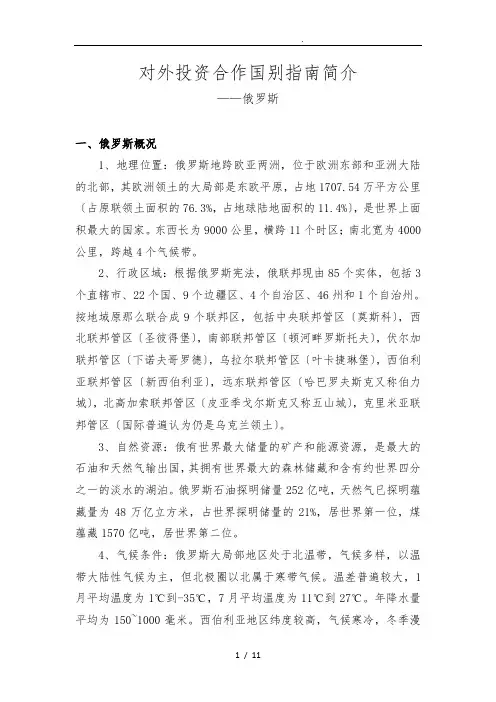
对外投资合作国别指南简介——俄罗斯一、俄罗斯概况1、地理位置:俄罗斯地跨欧亚两洲,位于欧洲东部和亚洲大陆的北部,其欧洲领土的大局部是东欧平原,占地1707.54万平方公里〔占原联领土面积的76.3%,占地球陆地面积的11.4%〕,是世界上面积最大的国家。
东西长为9000公里,横跨11个时区;南北宽为4000公里,跨越4个气候带。
2、行政区域:根据俄罗斯宪法,俄联邦现由85个实体,包括3个直辖市、22个国、9个边疆区、4个自治区、46州和1个自治州。
按地域原那么联合成9个联邦区,包括中央联邦管区〔莫斯科〕,西北联邦管区〔圣彼得堡〕,南部联邦管区〔顿河畔罗斯托夫〕,伏尔加联邦管区〔下诺夫哥罗德〕,乌拉尔联邦管区〔叶卡捷琳堡〕,西伯利亚联邦管区〔新西伯利亚〕,远东联邦管区〔哈巴罗夫斯克又称伯力城〕,北高加索联邦管区〔皮亚季戈尔斯克又称五山城〕,克里米亚联邦管区〔国际普遍认为仍是乌克兰领土〕。
3、自然资源:俄有世界最大储量的矿产和能源资源,是最大的石油和天然气输出国,其拥有世界最大的森林储藏和含有约世界四分之一的淡水的湖泊。
俄罗斯石油探明储量252亿吨,天然气已探明蕴藏量为48万亿立方米,占世界探明储量的21%,居世界第一位,煤蕴藏1570亿吨,居世界第二位。
4、气候条件:俄罗斯大局部地区处于北温带,气候多样,以温带大陆性气候为主,但北极圈以北属于寒带气候。
温差普遍较大,1月平均温度为1℃到-35℃,7月平均温度为11℃到27℃。
年降水量平均为150~1000毫米。
西伯利亚地区纬度较高,气候寒冷,冬季漫长,夏季日照时间长。
从西到东大陆性气候逐渐加强,冬季严寒漫长;从北到南依次为极地荒漠、苔原、森林苔原、森林、森林草原、草原带和半荒漠带。
5、人口资源:俄总人口1.431亿,共有民族193个,其中俄罗斯族占77%。
人口分布极不均衡,西部兴旺地区平均每平方公里52到77人,个别地方达261人,而东北部苔原带不到1人。
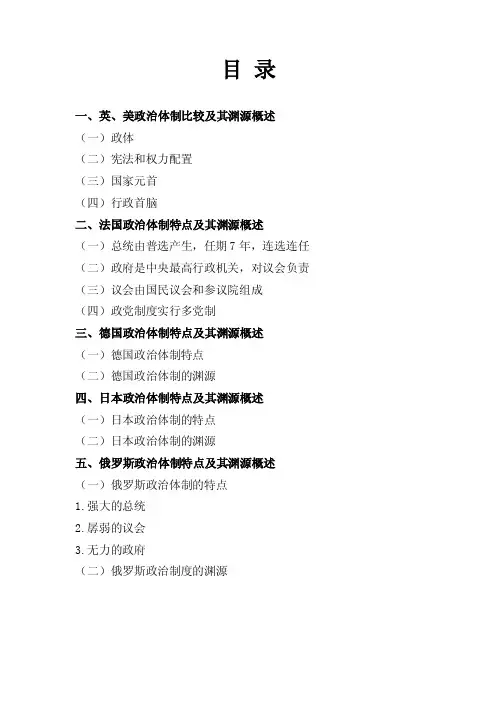
目录一、英、美政治体制比较及其渊源概述(一)政体(二)宪法和权力配置(三)国家元首(四)行政首脑二、法国政治体制特点及其渊源概述(一)总统由普选产生,任期7年,连选连任(二)政府是中央最高行政机关,对议会负责(三)议会由国民议会和参议院组成(四)政党制度实行多党制三、德国政治体制特点及其渊源概述(一)德国政治体制特点(二)德国政治体制的渊源四、日本政治体制特点及其渊源概述(一)日本政治体制的特点(二)日本政治体制的渊源五、俄罗斯政治体制特点及其渊源概述(一)俄罗斯政治体制的特点1.强大的总统2.孱弱的议会3.无力的政府(二)俄罗斯政治制度的渊源一、英、美政治体制比较及其渊源概述(一)政体英国实行单一制的政治体制,而美国则实行联邦制。
英国单一制是在商品货币关系发展,城市和市民兴起,以及资本主义生产方式的生长过程中,随着王权的加强,封建割据的消灭,而逐步形成和发展起来的。
十五世纪的英法百年战争(1337—1453)以及其后英国国内爆发的玫瑰战争(1455—1485) 也加速了英国国家的统一和政治集中的基本完成。
在百年战争刚刚结束后的两年(1455年) ,英国爆发了以兰开斯特和约克家族各为一方的长达三十年的王位争夺战,史称“玫瑰战争”,几乎英国所有世俗大贵族都卷入了这场战争。
战争对封建贵族实力的削弱为为英国君主专制政体的建立创造了条件。
于是,都铎家族的亨利七世及其后代在英国建立和发展了君主专制。
美国联邦系由原是英国在北美的十三个殖民地在反抗英国压迫的革命斗争中联合而成的,它由邦联演变而来。
美国自1776年宣布独立后,于次年制定了《邦联条例》,给原先各独立州的联盟以邦联的称谓。
作为一个松散的组织,邦联这一政权组织形式愈来愈不能适应独立战争后美国的国内外形势。
为尽快结束十三州各自为政的混乱局面,建立统一和强有力的中央政府,各州于1787 年制定了宪法,并将原先只具有协商性质的中央机构——邦联,改为获得各州授予权力,设有最高立法、行政、司法机构的联邦。
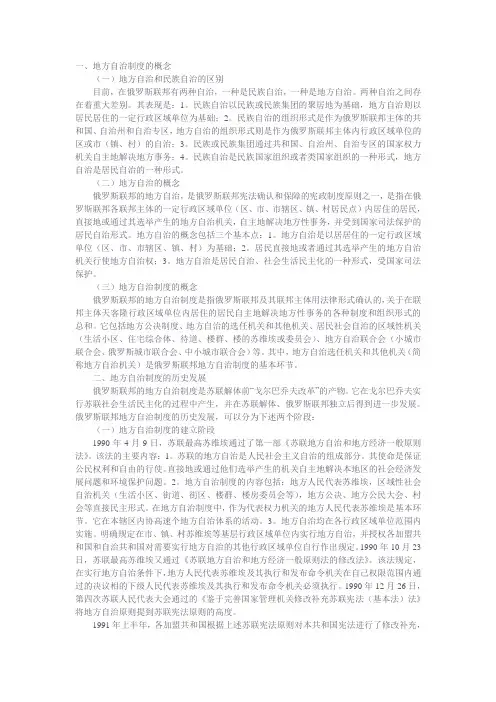
一、地方自治制度的概念(一)地方自治和民族自治的区别目前,在俄罗斯联邦有两种自治,一种是民族自治,一种是地方自治。
两种自治之间存在着重大差别。
其表现是:1。
民族自治以民族或民族集团的聚居地为基础,地方自治则以居民居住的一定行政区域单位为基础;2。
民族自治的组织形式是作为俄罗斯联邦主体的共和国、自治州和自治专区,地方自治的组织形式则是作为俄罗斯联邦主体内行政区域单位的区或市(镇、村)的自治;3。
民族或民族集团通过共和国、自治州、自治专区的国家权力机关自主地解决地方事务;4。
民族自治是民族国家组织或者类国家组织的一种形式,地方自治是居民自治的一种形式。
(二)地方自治的概念俄罗斯联邦的地方自治,是俄罗斯联邦宪法确认和保障的宪政制度原则之一,是指在俄罗斯联邦各联邦主体的一定行政区域单位(区、市、市辖区、镇、村居民点)内居住的居民,直接地或通过其选举产生的地方自治机关,自主地解决地方性事务,并受到国家司法保护的居民自治形式。
地方自治的概念包括三个基本点:1。
地方自治是以居居住的一定行政区域单位(区、市、市辖区、镇、村)为基础;2。
居民直接地或者通过其选举产生的地方自治机关行使地方自治权;3。
地方自治是居民自治、社会生活民主化的一种形式,受国家司法保护。
(三)地方自治制度的概念俄罗斯联邦的地方自治制度是指俄罗斯联邦及其联邦主体用法律形式确认的,关于在联邦主体天客隆行政区域单位内居住的居民自主地解决地方性事务的各种制度和组织形式的总和。
它包括地方公决制度、地方自治的选任机关和其他机关、居民社会自治的区域性机关(生活小区、住宅综合体、待道、楼群、楼的苏维埃或委员会)、地方自治联合会(小城市联合会、俄罗斯城市联合会、中小城市联合会)等。
其中,地方自治选任机关和其他机关(简称地方自治机关)是俄罗斯联邦地方自治制度的基本环节。
二、地方自治制度的历史发展俄罗斯联邦的地方自治制度是苏联解体前“戈尔巴乔夫改革”的产物。
它在戈尔巴乔夫实行苏联社会生活民主化的过程中产生,并在苏联解体、俄罗斯联邦独立后得到进一步发展。

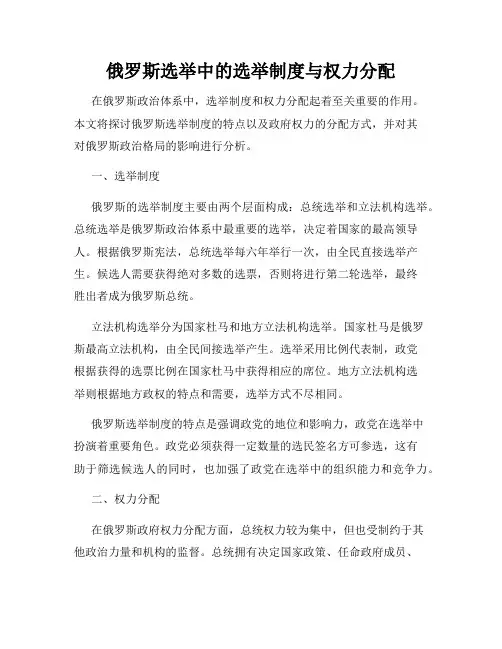
俄罗斯选举中的选举制度与权力分配在俄罗斯政治体系中,选举制度和权力分配起着至关重要的作用。
本文将探讨俄罗斯选举制度的特点以及政府权力的分配方式,并对其对俄罗斯政治格局的影响进行分析。
一、选举制度俄罗斯的选举制度主要由两个层面构成:总统选举和立法机构选举。
总统选举是俄罗斯政治体系中最重要的选举,决定着国家的最高领导人。
根据俄罗斯宪法,总统选举每六年举行一次,由全民直接选举产生。
候选人需要获得绝对多数的选票,否则将进行第二轮选举,最终胜出者成为俄罗斯总统。
立法机构选举分为国家杜马和地方立法机构选举。
国家杜马是俄罗斯最高立法机构,由全民间接选举产生。
选举采用比例代表制,政党根据获得的选票比例在国家杜马中获得相应的席位。
地方立法机构选举则根据地方政权的特点和需要,选举方式不尽相同。
俄罗斯选举制度的特点是强调政党的地位和影响力,政党在选举中扮演着重要角色。
政党必须获得一定数量的选民签名方可参选,这有助于筛选候选人的同时,也加强了政党在选举中的组织能力和竞争力。
二、权力分配在俄罗斯政府权力分配方面,总统权力较为集中,但也受制约于其他政治力量和机构的监督。
总统拥有决定国家政策、任命政府成员、组织安全机构等重要职权,然而宪法规定了总统权力的一些限制,并设立了一系列的制衡机制。
国家杜马在权力分配中起着重要角色。
虽然俄罗斯总统拥有广泛的行政权力,但大部分立法都需要得到国家杜马的批准。
国家杜马有权对政府工作进行监督,并可以提出不信任动议,限制总统权力的滥用。
此外,宪法法院在权力分配中也发挥着关键作用。
宪法法院负责审查法律和政府行政法规的合宪性,确保政府行为在法律框架内进行。
它是司法独立的象征,对权力滥用有不可忽视的制止作用。
三、影响与挑战俄罗斯选举制度和权力分配模式对政治格局产生着重要影响,同时也面临一些挑战。
首先,俄罗斯选举制度的特点加强了政党的地位,但也导致政党系统存在单一化趋势。
目前,主要政党的实力相对较强,而其他小党派的发展受限。
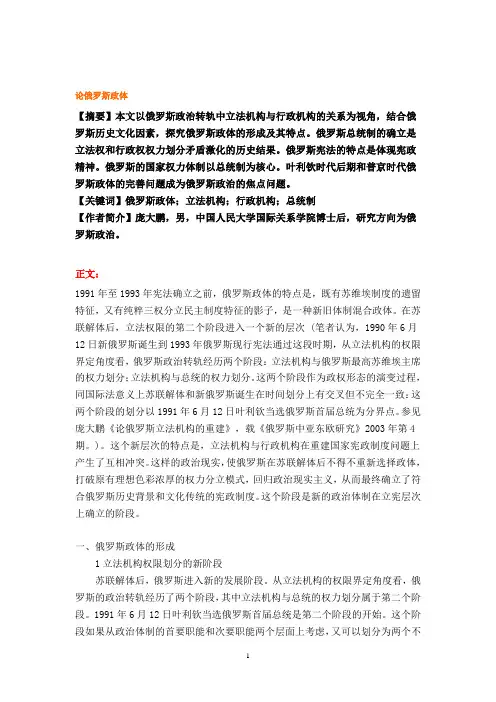
论俄罗斯政体【摘要】本文以俄罗斯政治转轨中立法机构与行政机构的关系为视角,结合俄罗斯历史文化因素,探究俄罗斯政体的形成及其特点。
俄罗斯总统制的确立是立法权和行政权权力划分矛盾激化的历史结果。
俄罗斯宪法的特点是体现宪政精神。
俄罗斯的国家权力体制以总统制为核心。
叶利钦时代后期和普京时代俄罗斯政体的完善问题成为俄罗斯政治的焦点问题。
【关键词】俄罗斯政体;立法机构;行政机构;总统制【作者简介】庞大鹏,男,中国人民大学国际关系学院博士后,研究方向为俄罗斯政治。
正文:1991年至1993年宪法确立之前,俄罗斯政体的特点是,既有苏维埃制度的遗留特征,又有纯粹三权分立民主制度特征的影子,是一种新旧体制混合政体。
在苏联解体后,立法权限的第二个阶段进入一个新的层次 (笔者认为,1990年6月12日新俄罗斯诞生到1993年俄罗斯现行宪法通过这段时期,从立法机构的权限界定角度看,俄罗斯政治转轨经历两个阶段:立法机构与俄罗斯最高苏维埃主席的权力划分;立法机构与总统的权力划分。
这两个阶段作为政权形态的演变过程,同国际法意义上苏联解体和新俄罗斯诞生在时间划分上有交叉但不完全一致:这两个阶段的划分以1991年6月12日叶利钦当选俄罗斯首届总统为分界点。
参见庞大鹏《论俄罗斯立法机构的重建》,载《俄罗斯中亚东欧研究》2003年第4期。
)。
这个新层次的特点是,立法机构与行政机构在重建国家宪政制度问题上产生了互相冲突。
这样的政治现实,使俄罗斯在苏联解体后不得不重新选择政体,打破原有理想色彩浓厚的权力分立模式,回归政治现实主义,从而最终确立了符合俄罗斯历史背景和文化传统的宪政制度。
这个阶段是新的政治体制在立宪层次上确立的阶段。
一、俄罗斯政体的形成1立法机构权限划分的新阶段苏联解体后,俄罗斯进入新的发展阶段。
从立法机构的权限界定角度看,俄罗斯的政治转轨经历了两个阶段,其中立法机构与总统的权力划分属于第二个阶段。
1991年6月12日叶利钦当选俄罗斯首届总统是第二个阶段的开始。
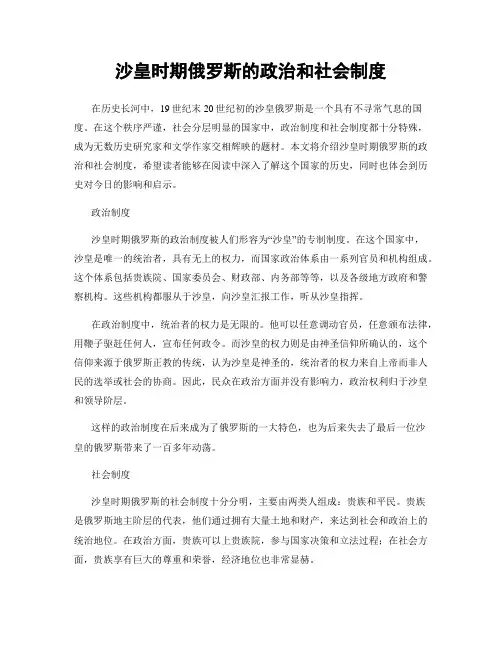
沙皇时期俄罗斯的政治和社会制度在历史长河中,19世纪末20世纪初的沙皇俄罗斯是一个具有不寻常气息的国度。
在这个秩序严谨,社会分层明显的国家中,政治制度和社会制度都十分特殊,成为无数历史研究家和文学作家交相辉映的题材。
本文将介绍沙皇时期俄罗斯的政治和社会制度,希望读者能够在阅读中深入了解这个国家的历史,同时也体会到历史对今日的影响和启示。
政治制度沙皇时期俄罗斯的政治制度被人们形容为“沙皇”的专制制度。
在这个国家中,沙皇是唯一的统治者,具有无上的权力,而国家政治体系由一系列官员和机构组成。
这个体系包括贵族院、国家委员会、财政部、内务部等等,以及各级地方政府和警察机构。
这些机构都服从于沙皇,向沙皇汇报工作,听从沙皇指挥。
在政治制度中,统治者的权力是无限的。
他可以任意调动官员,任意颁布法律,用鞭子驱赶任何人,宣布任何政令。
而沙皇的权力则是由神圣信仰所确认的,这个信仰来源于俄罗斯正教的传统,认为沙皇是神圣的,统治者的权力来自上帝而非人民的选举或社会的协商。
因此,民众在政治方面并没有影响力,政治权利归于沙皇和领导阶层。
这样的政治制度在后来成为了俄罗斯的一大特色,也为后来失去了最后一位沙皇的俄罗斯带来了一百多年动荡。
社会制度沙皇时期俄罗斯的社会制度十分分明,主要由两类人组成:贵族和平民。
贵族是俄罗斯地主阶层的代表,他们通过拥有大量土地和财产,来达到社会和政治上的统治地位。
在政治方面,贵族可以上贵族院,参与国家决策和立法过程;在社会方面,贵族享有巨大的尊重和荣誉,经济地位也非常显赫。
相比之下,平民的地位则十分低下。
大量的贫苦人民没有土地,没有财产,他们也没有任何政治权利。
他们不受保护,很难获取教育机会,基本上是沦为主人公人家的奴隶,想要逃离也难以为继。
这些人通常需要每天从早到晚去工作,以获取微薄的收入,但实际上他们也只是生活在贫困线以下的穷人,在社会上处于绝对的边缘。
在这样的社会制度下,俄罗斯的贵族阶层维护了其统治地位,同时也让贫苦人民不得不为其提供廉价的劳动力,自己也在生活的边缘苦苦挣扎。
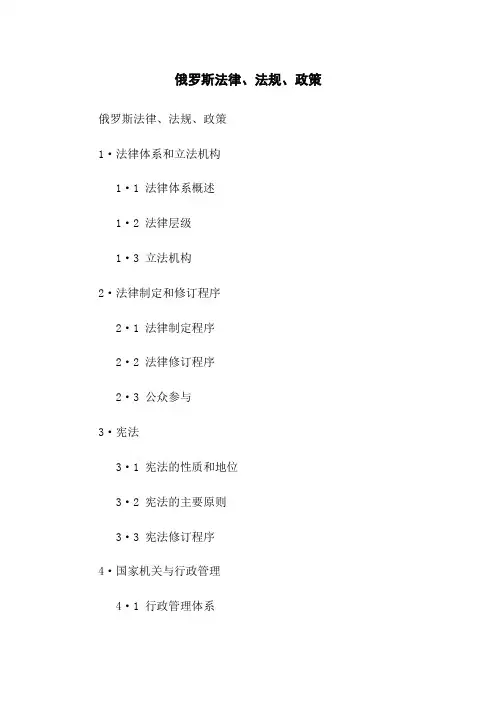
俄罗斯法律、法规、政策俄罗斯法律、法规、政策1·法律体系和立法机构1·1 法律体系概述1·2 法律层级1·3 立法机构2·法律制定和修订程序2·1 法律制定程序2·2 法律修订程序2·3 公众参与3·宪法3·1 宪法的性质和地位3·2 宪法的主要原则3·3 宪法修订程序4·国家机关与行政管理4·1 行政管理体系4·2 省级行政区划4·3 地方4·4 行政法规5·司法体系5·1 司法体系概述5·2 法院系统5·3 司法程序与审判程序 5·4 法官任命与资格要求6·经济法律和政策6·1 反垄断法律6·2 投资法律和政策6·3 公司法律和政策6·4 劳动法律和政策7·知识产权法律和政策7·1 版权法律和政策7·2 商标法律和政策7·3 专利法律和政策7·4 消费者权益法律和政策8·教育法律和政策8·1 教育法律框架8·2 教育管理体系8·3 学校管理与监督8·4 教育质量评估机构9·环境法律和政策9·1 环境保护法律9·2 自然资源管理9·3 污染控制与治理9·4 环境评估和监测机构10·刑法和刑事司法体系10·1 刑法规定10·2 刑事偵查与刑事诉讼程序 10·3 刑罚与刑事处罚执行10·4 刑事司法机构11·民事法律和争议解决机制11·1 民事责任法律11·2 合同法律11·3 知识产权民事案件解决机制11·4 仲裁制度12·附件附件1:宪法全文附件2:相关法律和法规法律名词及注释:1·法律体系:由一系列法律、法规和判例组成的整体。
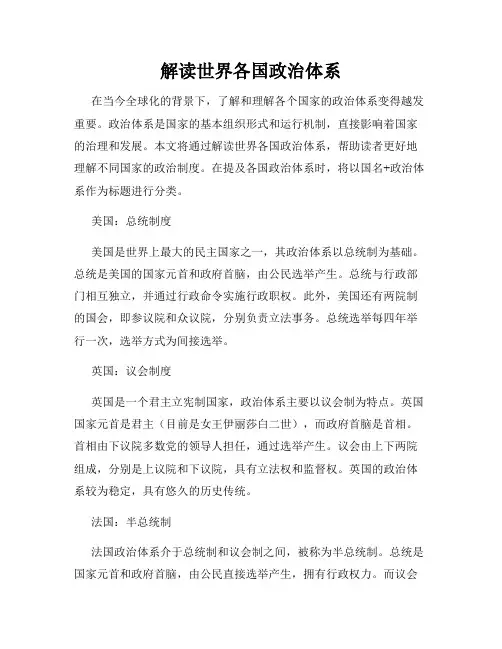
解读世界各国政治体系在当今全球化的背景下,了解和理解各个国家的政治体系变得越发重要。
政治体系是国家的基本组织形式和运行机制,直接影响着国家的治理和发展。
本文将通过解读世界各国政治体系,帮助读者更好地理解不同国家的政治制度。
在提及各国政治体系时,将以国名+政治体系作为标题进行分类。
美国:总统制度美国是世界上最大的民主国家之一,其政治体系以总统制为基础。
总统是美国的国家元首和政府首脑,由公民选举产生。
总统与行政部门相互独立,并通过行政命令实施行政职权。
此外,美国还有两院制的国会,即参议院和众议院,分别负责立法事务。
总统选举每四年举行一次,选举方式为间接选举。
英国:议会制度英国是一个君主立宪制国家,政治体系主要以议会制为特点。
英国国家元首是君主(目前是女王伊丽莎白二世),而政府首脑是首相。
首相由下议院多数党的领导人担任,通过选举产生。
议会由上下两院组成,分别是上议院和下议院,具有立法权和监督权。
英国的政治体系较为稳定,具有悠久的历史传统。
法国:半总统制法国政治体系介于总统制和议会制之间,被称为半总统制。
总统是国家元首和政府首脑,由公民直接选举产生,拥有行政权力。
而议会由国民议会和参议院组成,负责立法和监督职能。
总统有较大的行政权力,但仍需与议会协商和合作。
法国的政治体系具有较高的集权性,总统在行政决策中起着重要作用。
中国:社会主义制度作为世界上最大的社会主义国家,中国的政治体系以中国共产党领导为特点。
中国是一个人民代表大会制度的国家,国家权力由全国人民代表大会和地方各级人民代表大会行使。
中国共产党对国家的政治决策起着重要指导作用。
国家主席是国家元首,国务院总理是政府首脑。
中国政治体系强调党的领导,并注重人民的民主参与。
德国:议会制度德国是一个议会制国家,政治体系以联邦议会为核心。
联邦议会由联邦议院和联邦参议院组成,负责立法事务。
总统是国家元首,以代表国家形象和行使象征性权力为主要职责。
政府首脑是由议会选举产生的总理,行使行政权力。
现代俄罗斯的政治体制与权力平衡俄罗斯作为世界上最大的国家之一,其政治体制和权力平衡一直备受关注。
自苏联解体以来,俄罗斯经历了多次政治变革和权力重组,不断适应着国内外的形势变化。
本文将从历史发展角度出发,探讨现代俄罗斯的政治体制和权力平衡。
俄罗斯政治体制的演变与发展自沙皇时代开始,俄罗斯一直处于集权统治的政治体制之下。
而在1917年的十月革命后,苏联建立起了一个社会主义政权,实行共产主义制度。
然而,正如我们所熟知的,苏联在20世纪90年代解体,俄罗斯成为独立国家。
在转型期间,俄罗斯面临着巨大的政治和经济挑战。
首先,政治上的权力空心化成为一种普遍现象。
由于体制变革,原本握有大权的共产党垮台,取而代之的是一系列针对权力平衡的改革。
然而,由于缺乏明确的权力分配机制,俄罗斯政治陷入了混乱和争夺的局面。
权力平衡的探索与实践随着时间的推移,俄罗斯政府逐渐建立了一种更为稳定的政治体制。
在普京总统的主导下,俄罗斯采取了一系列措施以实现权力平衡。
首先,社会制度的稳定被强调,通过加强法律和司法体系的建设,以确保公民的权益得到保护和尊重。
其次,政治权力的分散化也成为目标。
普京总统在任内采取了一系列措施来削弱地方政府和地方政权的影响力,以保持中央政府的统一性和控制力。
这种做法旨在加强中央政府的主导地位,避免地方政权的独立性对国家的不利影响。
此外,经济发展也被视为实现政治权力平衡的关键因素。
作为一个资源丰富的国家,俄罗斯政府致力于提高国家的经济实力。
通过吸引外国投资、发展国内产业以及采取一系列财政和金融政策,俄罗斯取得了一定的经济成就,从而为政治体制的稳定和权力平衡奠定了基础。
挑战与前景展望然而,现代俄罗斯的政治体制和权力平衡仍然面临一些挑战。
首先,仍然存在着权力集中的倾向。
尽管俄罗斯采取了一系列措施来实现权力分散化和地方政府改革,但仍然存在权力过于集中于中央政府的问题。
这种集权化的特点可能导致政府对地方政权的过度干预,从而损害了地方政府的独立性和自治性。
俄罗斯历史英文作文英文:Russian history is a fascinating subject that spans centuries of political, social, and cultural evolution. From the earliest days of the Kievan Rus to the modern eraof Putin's Russia, the country has seen its share of triumphs and tragedies.One of the most significant events in Russian history was the reign of Peter the Great in the 18th century. He transformed Russia from a backward, isolated nation into a powerful European power, modernizing its military, industry, and culture. His legacy can still be seen in the grandeurof St. Petersburg, which he founded as his new capital.Another pivotal moment in Russian history was the Bolshevik Revolution of 1917, which led to theestablishment of the Soviet Union. The Soviet era saw dramatic changes in the country's economy, society, andpolitical system, as well as the rise of communism as a global ideology. However, it was also marked by repression, censorship, and human rights abuses, which continue to shape Russia's political landscape today.Despite these challenges, Russia has produced some of the world's greatest writers, artists, and thinkers, including Tolstoy, Dostoevsky, Tchaikovsky, and Chekhov.Its rich cultural heritage is a testament to the resilience and creativity of the Russian people, who have endured centuries of hardship and adversity.中文:俄罗斯历史是一个令人着迷的主题,跨越了政治、社会和文化演变的数个世纪。
解读世界大国的政治体制随着全球化的加剧和国际地位的提升,世界大国的政治体制备受关注。
这些大国在政治体制上各具特色,从某种程度上反映了它们的历史、文化和价值观。
本文将从不同角度解读世界大国的政治体制,包括中国、美国、俄罗斯和印度。
首先,中国的政治体制在世界上独树一帜。
中国是一个社会主义国家,政治体制采用中国共产党领导的多党合作和政治协商制度。
这种体制注重集中统一的领导,充分发挥了中国共产党在政治决策中的主导作用。
与西方国家不同,中国的政治体制强调稳定和社会和谐。
此外,中国还注重基层民主,通过各级人民代表大会和政协各界人士的政治协商,充分发挥人民群众的主体地位,提高政策的代表性和参与性。
与中国不同,美国是一个民主共和国。
美国的政治体制采用的是三权分立的制度,即行政、立法和司法权力独立且相互制衡。
这种体制注重民主的政治决策和权利保障。
美国的选举制度开放和竞争性,允许公民自由地表达意见并参与政治活动。
此外,美国强调每个州的自治和地方政府的重要性,允许地方政府有更大的自主权。
然而,美国体制也存在一些问题,如选举费用过高和政治腐败等。
俄罗斯是一个以总统为核心的半总统制国家。
俄罗斯的政治体制注重权力的集中和垂直管理。
总统在国家政治决策中起着关键作用,对国家机构有最终决策权。
此外,俄罗斯的政党系统相对集中,主要以“统一俄罗斯党”为核心。
然而,俄罗斯的政治体制也存在一些问题,如缺乏民主制度的建设和公民社会的发展不足。
印度是一个多党制国家,政治体制体现了民主和宗教多样性。
印度的政府由总统、总理和政事会组成。
政治决策和权力分布在中央政府和各邦政府之间。
印度的政党制度自由,允许各种政治力量的竞争和发展。
尽管如此,印度的政治体制也面临一些挑战,如腐败和宗派主义等。
综上所述,世界大国的政治体制各有特色,反映了国家的历史、文化和价值观。
中国注重稳定和集中统一的领导,美国注重民主权利和三权分立,俄罗斯注重权力集中和垂直管理,印度注重宗教多样性和多党制。
在政治方面,中国和俄罗斯的政府结构有何不同?政治结构是各国政治制度的基础,在各国政体中起着至关重要的作用。
中国和俄罗斯,作为两个世界上最大的发展中国家和大国,其政府结构具备独特的特点,下面我们就来详细探讨一下,在政治方面,中国和俄罗斯的政府结构有何不同?一、政治体制的差异中国的政治体制是“人民代表大会制度”,由全国人民代表大会和地方各级人民代表大会构成。
它是一个单一的国家政权,由中央政府行使最高权力。
而俄罗斯的政治体制则是“总统制”,由总统、政府和议会构成。
其政府部门由参议院和众议院组成,议会具有立法权。
二、官方行政职能的差异中国的国家行政机构是由各部委、厅局、省、市、区等地方政府组成的层级结构,其中国务院是最高行政机构。
而俄罗斯的行政机构是由各部委、地方政府等组成的层级结构,政府是最高行政机构,由总理领导。
在中国,地方政府的权力主要由中央政府授权。
而在俄罗斯,地方政府比较独立,拥有自己的财政预算等自主权。
三、选举制度的差异中国的选举体系是由人民代表大会选举产生,包括全国人民代表大会和各级地方人民代表大会。
而俄罗斯的选举体系则是由普选产生,通过总统选举产生总统,通过议员选举产生议员。
在中国,民主机制依然需要加强,民主选举体系也还有不足,而在俄罗斯,一些选举存在舞弊和不公平的现象,被批评为缺乏透明度。
四、反腐斗争的差异反腐斗争是一个国家的必需品,也是中国和俄罗斯近年来的重点工作之一。
中国选出的领导层通过坚决打击贪污腐败的方式,控制了一批高级领导人的腐败现象。
而在俄罗斯,反腐工作同样得到了重视,针对一些政府部门的腐败现象进行了打击。
但由于俄罗斯的政治体制和选举制度相对不透明,很难保证反腐斗争能够得到有效的实施。
总结:中国和俄罗斯的政府结构虽然存在不同之处,但都在积极探索各自的政治制度,为国家的长远发展付出努力。
同时,我们也希望在政治方面,中国和俄罗斯能够更加紧密地合作,为全球和平和稳定作出更大的贡献。